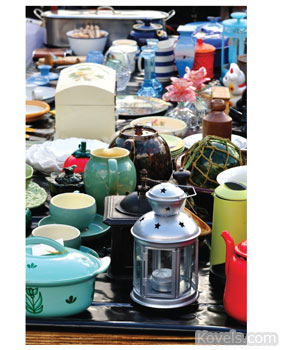Springtime means flea markets, and the Kovels have shopped flea markets for years. April and May are good months for flea markets and shows. Vintage merchandise found over the winter is finally for sale, and dealers who saw slow sales in this winter of bad weather need cash to buy more. Here are Kovels' Top 10 Tips to help anxious collectors get ready to buy and bargain.
Before:
1. Put together a grab-and-go "flea market kit." Gather a magnifying glass (to help read marks on silver or china), flashlight (to find labels, marks and construction clues on the bottom or the back of furniture), a small tape measure (handy to make sure furniture will fit through the door after you get it home), and a large canvas tote. If you are planning to hunt for vintage battery-operated toys, bring along some batteries – C and AA. Add some pre-moistened towlettes, a large, light rain poncho and some bottled water.
2. Be prepared to shop, share and ship with the latest smartphone apps. There are apps and websites to help collectors find flea markets, food, shipping locations – even public bathrooms and your parked car! Modern apps can also measure, magnify, evaluate prices and organize a "favorites" list.
3. Dress for the weather, in layers and bright colors (so your friends can find you!) and wear comfortable shoes and a hat. Sun-protective clothing is widely available now. Be sure to use suntan lotion and protective lip balm.
4. Bring cash, a few checks and a credit card, too. Be sure it's all safely zipped away. Some dealers accept checks or credit cards, but many will not. Some shows have ATM machines available. You can often get a better price if you pay with cash.
During:
5. Try starting at the back. Some collectors start at the front of a flea market and work their way to the back. Head to the back first – things might not have been picked over yet.
6. See something you want but it's too heavy to carry around? Pay for it, then use your phone to take a picture of the item and the number on the booth so you can easily pick your purchase up later. Some flea markets have "runners" who will cart your large purchases to a pickup spot near parking.
After:
7. Serious shoppers start early. But once it gets near closing time, sellers drop their prices or are willing to bargain so they will have less to pack, especially those with heavy pieces or large rugs.
8. Have packing material like newspapers, bubble wrap, boxes or old blankets for wrapping breakables handy. In your car, keep a rope or bungee cords to hold items on top or to secure an open trunk. Don't forget a screwdriver, hammer and rust-loosening oil in case you have to dismantle a bed or table to fit it in your car.
9. Flea Market Strategies: How to Shop, Buy and Bargain the 21st-Century Way is a new booklet by Terry and Kim Kovel, and available only in the online store at Kovels.com. This 17-page booklet offers tips on spotting fakes, advice about paying for purchases, shipping suggestions and lists of popular flea markets. It also has a supplement that lists current apps and websites.
10. Don't forget the Kovels' cardinal rules: Buy it when you see it because you might never see it again," "Don’t worry about how to get it home, you can find a way,” and “Always negotiate price.”




Ask the price before you pick up the item to look at it,
Once you start looking for the markings or show too much interest the price goes up because they know you want it.
Make sure you know your shopping buddies phone number and the phone is fully charged. That way you can split up and call if there is something outstanding one of you is looking for. Good way to find each other if you separate. Small black light to check for repairs too and see if it really is uranium glass..
I always carry a small black light. It will help detect repairs as a lot of glues will glow under black light. You can get a small light at a pet store-it will also cause pet urine to glow.
Thank you so much for all the interesting stories, facts and tips you provide. I always look forward to my email when I see its from KOVELS Thank you again.
CB
If you go with anyone else, set a meeting time and place BEFORE plunging happily into shopping! There’s a very good chance that you’ll become separated as you shop, and you can’t always rely on cell phone reception and/or batteries to come through when you need them. And be sure that your meeting place is easy to identify and is a comfortable place to wait in case one of you gets there early!
Before you fall in “love” with items , always ask if the prices are firm. If they say not firm then they will be prepared to haggle when you are checking out. If they say the prices are firm then accumulate the items you want and ask them if they will accept a certain lessor lot amount. Some times at garage sales there will be more than one taking money. Use your ears to see which one is willing to lower a price / haggle. But at times you will run into a firm price seller.
Thank you so much fo9r these wonderful tips.
I plan to use every one of them.
I might suggest adding a magnet to your grab-and-go Flea market Kit. It will help to remove any doubt that an item is either made from ferrous metal that has been plated, or, has some other type of metallic finish applied to it.